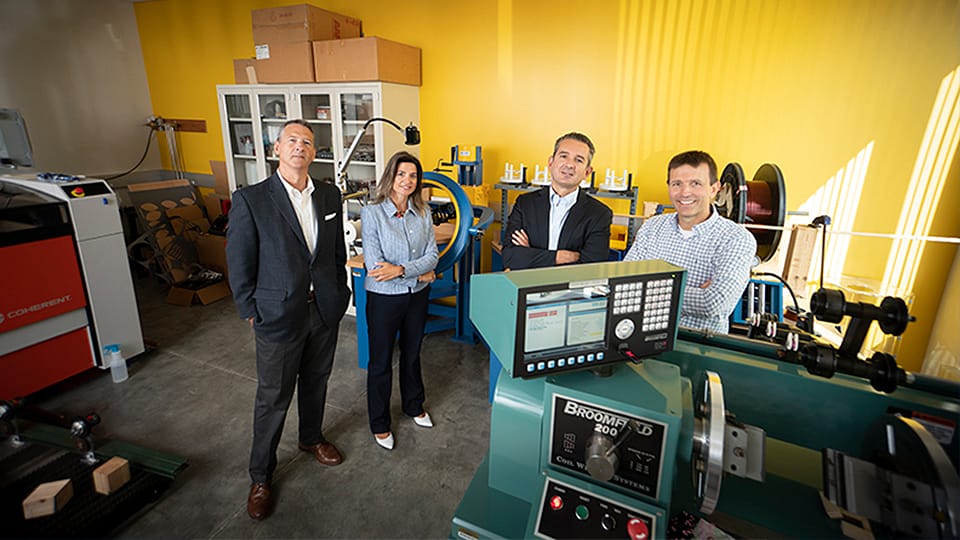Electric charging roadway research nearing field testing
Subscriber Benefit
As a subscriber you can listen to articles at work, in the car, or while you work out. Subscribe Now
The Indiana Department of Transportation, Purdue University, and Columbus-based Cummins are moving forward with the next phase of a project designed to build what they’re calling a first-of-its-kind roadway that can charge both heavy-duty and passenger electric vehicles while driving.
The effort comes after years of research to develop concrete pavement that can be used to wirelessly charge vehicles.
A pilot segment will be constructed on a short stretch of road near INDOT’s sub-district office in West Lafayette, which will be used to test the technology’s effectiveness on a Class 8 heavy-duty electric truck provided by Cummins.
John Haddock, a professor of civil engineering at Purdue, told Inside INdiana Business the pilot segment follows years of testing in a smaller setting on Purdue’s campus.
“We’ve had a couple of the charging units in a smaller pavement; we have the accelerated payment facility here in town. We’ve had 50,000 or so passes over them, so we have a comfort level now. They don’t cause any mechanical problems with the pavement. They don’t appear to cause any thermal problems with pavement either. So that’s given us a little more surety that we can go into a bigger pilot project.”
Haddock also noted that the electrical technology that will be used in the concrete units has evolved over the last couple of years and will be different than what was tested at Purdue previously.
The technology involves a series of wire coils that are buried under the surface of the pavement that are hooked up to electronics that create an inductive charge similar to when a cell phone is laid down on a charger.
The test area involves a stretch of U.S. 231/U.S. 52 between Cumberland Avenue and Lindberg Road in West Lafayette, which is less than one mile.
Work on the project, which is being constructed by Clinton-based White Construction, is slated to begin on Monday. Crews will close the westbound right lane to begin pavement removal.
Blake Dollier, public relations director for INDOT’s West Central district, said finally getting to this point is exciting for the department.
“Our goal with all of this is to finally take the test successful tests we’ve done in the lab and really put this into practice,” he said. “We want to put this out onto a road. It’s the first of its kind project in the United States, and to bring that to West Lafayette and be able to take that and get the ball kind of rolling on something that could be a very futuristic project, it’s something we’re thrilled to do. And it’s something that we really hope can lead to more innovation down the road.”
Cummins came on board the project about a year and a half ago, according to John Kresse, director of hybrid and electrification technologies for the company. He said Cummins has been investigating ways to grow electric charging capabilities for heavy-duty trucks in a cost-effective manner.
“One of the greatest challenges for commercial vehicle electrification is how do you charge the battery? Where do you charge it? How fast? What’s the cost?,” he said. “The build out in the charging infrastructure has been probably pretty slow, slower than most maybe had foreseen or had wanted. You look at the technology, and while it’s speculative, if it can be done cost effectively, installed, maintained, and operated cost effectively, there could be tremendous benefits to the fleet operators.”
Cummins is integrating the charging systems developed at Purdue into their Class 8 battery electric demo vehicles. Kresse said the collaboration with Purdue involved providing each other with the size requirements for the technology that will be installed in the vehicles and then doing the design work.
The efficiency of the wireless power transfer, Kresse said, could be comparable to a wired system. And the goal is to provide a beneficial option for electrical charging for fleet operators.
“If you can charge while you’re running down the road, then the truck is making money for the operator,” he said. “Perhaps the truck can have a smaller battery, so maybe it costs less, [which is] also good for the truck operator. Maybe you can charge it at a lower power because you’re on the on the roadway for longer than you’d be stopped; that could let lead to longer battery life. I think the upside is huge.”
Construction is expected to continue through the fall, weather permitting. Additional work is expected to last until May of 2025.
Both Kresse and Haddock say it’s unclear what the outcome of the testing will be because it’s such a new technology. But Haddock noted they expect to learn a lot not just from the technology side of things.
“While it’s being built, we’re going to learn some things about construction,” he said. “We’ve been so focused on having [the technology] in the pavement and what that’s going to do that we haven’t paid as much attention to the construction part.”
Once they begin testing, Haddock said the team hopes to get more information from the electronics to help refine the system and make it more efficient and reduce costs.
Ultimately, the team aims to be able to create standard components to make installing the technology around the country a cost-effective reality.
